Office lighting plays a critical role in creating a productive work environment. Good lighting can enhance the aesthetic appeal of an office space and significantly influence the employees’ mood, energy levels, and productivity.
According to a study by the American Society of Interior Design, 68% of employees complain about the lighting situation in their offices. Therefore, it is essential to carefully consider the different types of lighting fixtures available for office spaces and choose the ones that best meet the needs of your employees.
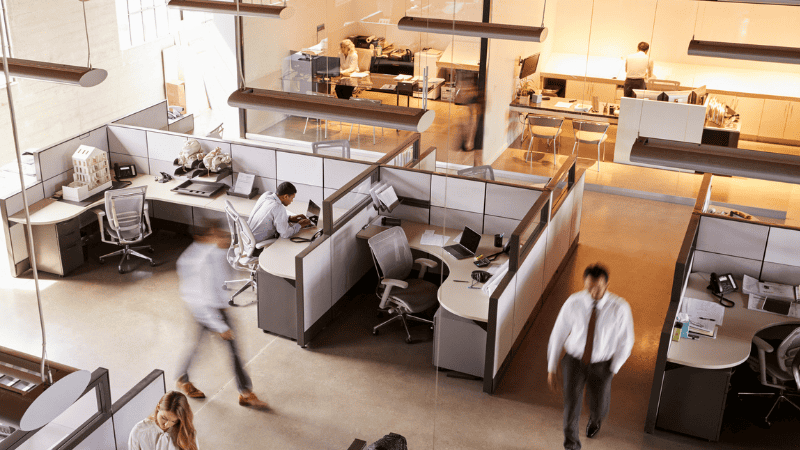
So, what types of different office lighting fixtures should you consider for office use? Let’s get into the details.
Understanding the Importance of Office Lighting
Office lighting is more than just a design element; it profoundly impacts workplace productivity and employee health.
1. Productivity
The quality of light directly influences employees’ productivity in a workspace. A study revealed that poor lighting can cause eyestrain, headaches, and physical fatigue, reducing work efficiency and increasing errors. On the other hand, well-designed lighting systems can improve mood and increase energy levels, enhancing overall productivity.
2. Health
Aside from productivity, office lighting fixtures also affect the health of employees. According to a report by the Lighting Research Center, exposure to natural light during the day can regulate circadian rhythms, thereby improving sleep, mood, and overall quality of life. Besides, proper lighting can also prevent eye strain and other long-term vision problems.
3. Employee Well-being and Comfort
In addition to productivity and health, lighting also plays a significant role in the well-being and comfort of employees.

Poor lighting can cause discomfort, leading to distractions and reduced concentration levels. On the other hand, appropriate lighting can create a comfortable and inviting environment that helps employees stay focused and motivated.
4. Energy Efficiency and Environmental Impact
Choosing the right office lighting fixtures can also impact energy efficiency and the environment. Traditional incandescent bulbs consume a lot of energy and contribute to carbon emissions.
Switching to energy-efficient options such as LED or CFL lights not only reduces energy costs but also helps in reducing the carbon footprint of your office.
Ask For Free Quote
Let us Respond Promptly for your Needs :)
What Types of Lighting are Used in Offices?
The following are the most commonly used types of lighting in offices:
1. Incandescent Office Lighting
Incandescent lighting, the oldest form of electric lighting, is often used in offices due to its warm, inviting glow. These lights work by heating a wire filament until it glows, producing a pleasing light to the eye.
However, they are not the most energy-efficient option, as most energy is transformed into heat rather than light. Also, incandescent bulbs have a shorter lifespan than other lighting types. Despite their drawbacks, they are commonly used for accent lighting and in areas where creating a cozy atmosphere is crucial.
2. Fluorescent Office Lights
Fluorescent ceiling fixtures are another popular choice, known for their energy efficiency and long lifespan. They emit a cool, bright light that covers a large area, making them an ideal choice for general office lighting.
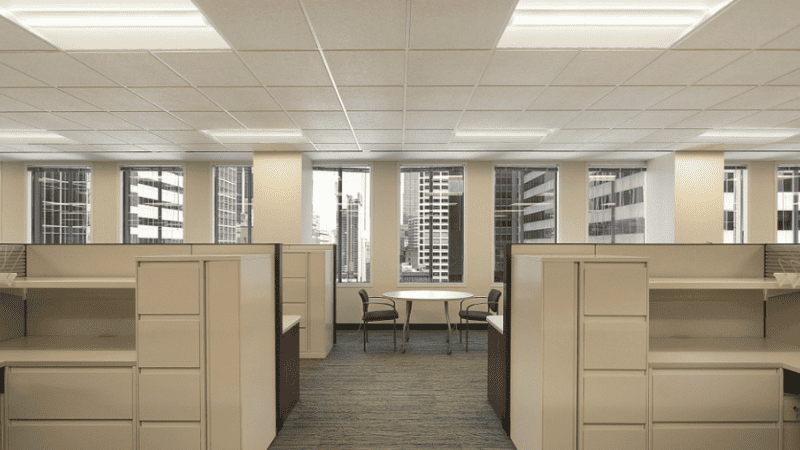
Fluorescent lights work by passing an electric current through a tube containing mercury vapor. This generates ultraviolet light that triggers the phosphor coating inside the tube to glow, producing visible light.
However, the quality of light can sometimes appear harsh and cause glare, which may lead to eye discomfort. Therefore, using these lights in combination with other lighting types is recommended for a balanced lighting scheme.
3. LED Office Lighting
LED office lights are the most energy-efficient and eco-friendly option available. These lights use light-emitting diodes to produce light and consume less energy than incandescent or fluorescent bulbs, making them a cost-effective choice for long-term use. They also have a longer lifespan, reducing maintenance costs.
Moreover, LED office lighting fixtures offer various color temperatures, allowing you to adjust the lighting according to the needs of your office space and employees. They also do not emit UV rays, making them ideal for areas that require precise color accuracy, such as graphic design studios.
Ask For Free Quote
Let us Respond Promptly for your Needs :)
7 Types of Common Office Lighting Fixtures
Below are the most common types of office lighting fixtures:
1. Flat Panel LED Light
Flat Panel LED lights are a versatile and modern option often used in office environments for their sleek design and superior lighting quality.
Known for their uniform light distribution, they can be either recessed into drop ceilings, surface-mounted, or suspended, making them suitable for various office spaces.
Due to their bright, non-glaring light, the flat panel LED lights are excellent for general lighting in office workspaces, meeting rooms, and corridors.
They can effectively reduce shadows and hotspots, enhancing visual comfort for employees. Moreover, these LED lights are also commonly used in task-oriented spaces such as reading areas and computer desks.
2. Ceiling Office Lights
Ceiling office lights, or overhead lights, are the most common type of lighting used in offices. These lights are installed on the ceiling, providing general ambient light to an entire room. Depending on the ceiling height, they can be mounted as surface-mounted fixtures or recessed lights.
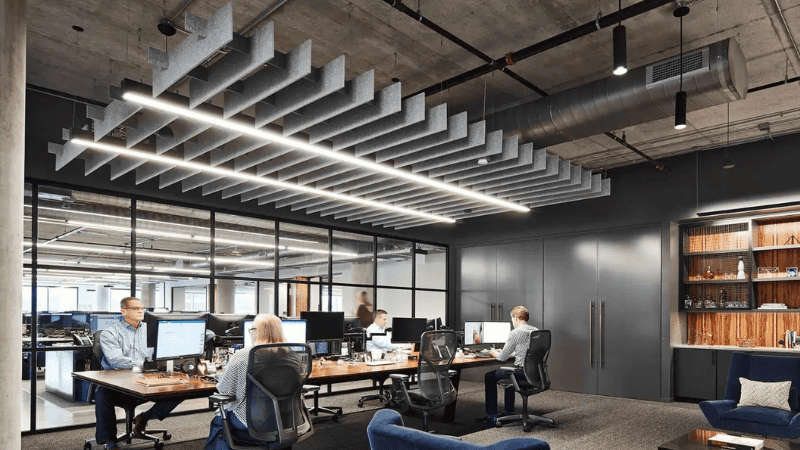
Office ceiling lights come in various designs, such as flush mount, semi-flush mount, and pendant lights. They are suitable for general lighting in open-plan offices, reception areas, and hallways.
Ceiling office lights often use fluorescent or LED bulbs, making them an energy-efficient option for large office spaces.
3. Recessed Downlights
Recessed downlights are ceiling-mounted fixtures installed inside the ceiling to create a clean, streamlined look. These lights focus on workstations, conference tables, and reception desks. Recessed downlights are also commonly combined with other lighting types to create a layered lighting scheme in offices.
These fixtures come in various sizes and shapes, such as round or square, allowing you to customize the design according to the aesthetics of your office. LED recessed downlights are an excellent choice for energy efficiency and can provide warm or cool light depending on the color temperature.
4. Track Lighting
Track lighting is a versatile and flexible form of lighting that can be configured in various ways to suit the specific lighting needs of an office space.
It comprises a continuous track with several light fixtures that can be adjusted and moved along the track, offering customization ideal for highlighting specific areas or architectural features.
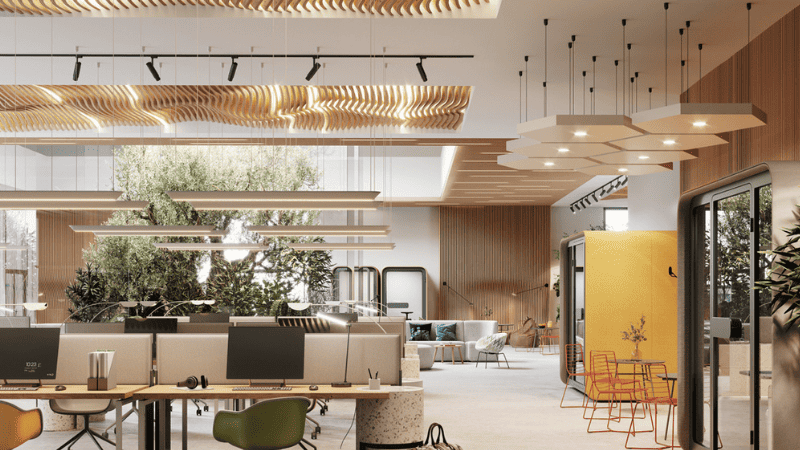
These lighting solutions can provide focused lighting, making them excellent for task-oriented spaces such as design studios, libraries, or areas displaying artwork or documentation.
Track lighting can also be ambient in open-plan offices with the right fixtures and bulbs. They are typically used with LED light bulbs, ensuring energy efficiency and longevity.
5. Emergency/Exit Lighting
Emergency/Exit lighting is a critical lighting system in office spaces designed to guide occupants toward safe exits in case of an emergency or power outage.
These lights are strategically placed along evacuation routes, leading to emergency exits and fire escape stairs. They are primarily powered by backup batteries, ensuring they remain operational even during power failures.
The illumination provided by emergency/exit lights is crucial for safety, enabling visibility in potentially chaotic situations and reducing panic.
These fixtures are required by law in most commercial and public buildings, demonstrating their vital role in ensuring safety. They come with clear, universally recognized signage, often as an illuminated ‘exit’ text or a running figure, allowing people of all languages and nationalities to understand their purpose.
6. LED Troffer Lighting
LED Troffer Lighting is a popular choice for office lighting because it provides high-quality, uniform light. These lights are rectangular or square fixtures designed to fit into a modular dropped ceiling grid or can be surface mounted.
Ask For Free Quote
Let us Respond Promptly for your Needs :)
LED Troffer Lighting is typically used for general lighting in office spaces, conference rooms, and lobbies. These fixtures deliver bright and consistent light across the room, reducing shadows and making reading and detailed tasks easier.
They come in various sizes and color temperatures, providing flexibility in matching the aesthetics and lighting requirements of the office.
7. LED Linear Lighting
LED Linear Lighting is a system characterized by long, straight fixtures that provide continuous and uniform illumination.
Perfectly suited to modern office environments, these lighting solutions are renowned for their sleek, minimalist design and efficient lighting coverage. They can be mounted on the ceiling, installed in a suspended fashion, or even recessed catering.
Due to its consistent and wide light spread, this lighting fixture is ideal for illuminating large areas, such as open-plan offices, hallways, and breakout areas.
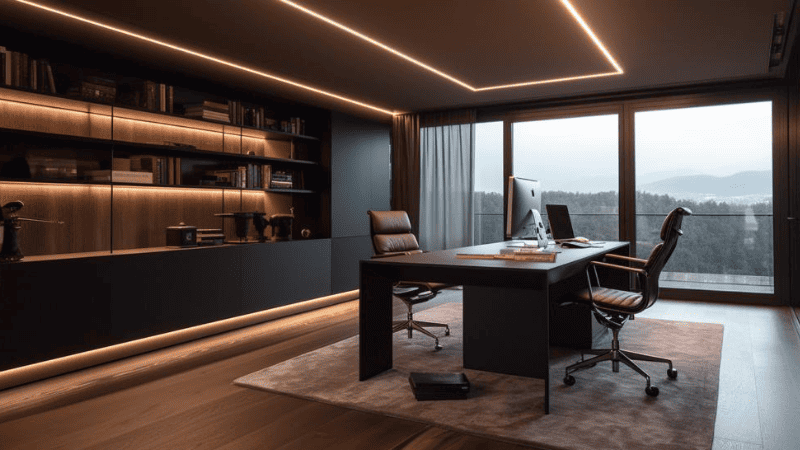
It minimizes dark spots and shadows, offering a comfortable lighting environment for office tasks. Moreover, they are highly energy-efficient and have a long lifespan, thus contributing to long-term cost savings and sustainability goals.
Mistakes to Avoid While Choosing Office Light Fixtures
Selecting the right office light fixtures can be a complicated process, and there are some common mistakes that you should avoid to ensure optimum lighting for your workspace. These include:
- Wrong color temperature: Selecting the wrong color for your office lighting can significantly impact productivity and employee well-being. Warm light (2700K-3000K) creates a cozy and relaxed atmosphere, while cool light (3500K-5000K) promotes alertness and focus.
- Wrong position: Placing light fixtures is crucial in achieving the desired lighting effect. Avoid placing lights directly above computer screens or workstations, leading to glare and eye strain. Also, ensure that there is uniform lighting throughout the entire office space.
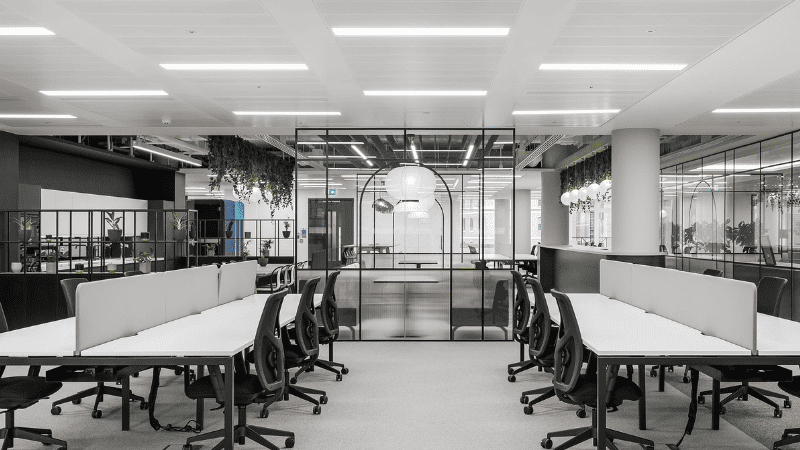
- Wrong brightness: Lighting that is too dim or bright can cause discomfort, eye strain, and headaches. It is essential to strike a balance and provide sufficient lighting for tasks without causing discomfort.
- Ignoring energy efficiency: As mentioned earlier, choosing energy-efficient light fixtures benefits the environment and offers cost-saving benefits in the long run. Avoid selecting traditional incandescent bulbs and opt for LED or CFL options.
Ask For Free Quote
Let us Respond Promptly for your Needs :)
FAQs
What Is the Best Light Fixture for an Office Space?
The best light fixture for an office space depends on the space’s specific lighting needs and aesthetics. Some popular choices include ceiling lights, recessed downlights, track lighting, LED troffers, and linear lighting. It is best to consult a professional to determine the most suitable option for your office.
What Is the Standard for Office Lighting?
Local building codes or industry standards typically set the standard for office lighting. Generally, the recommended light levels for office spaces are between 300-500 lux (lumens per square meter) for general lighting and between 500-1000 lux for task-specific areas.
What Is the Best Light for Reading and Computer Work?
It is best to ensure a good balance of general and task-specific lighting for reading and computer work. LED lights with a color temperature of 3000-4000K (warm or cool white) are ideal for reading and computer work as they provide sufficient brightness without causing eye strain or glare.
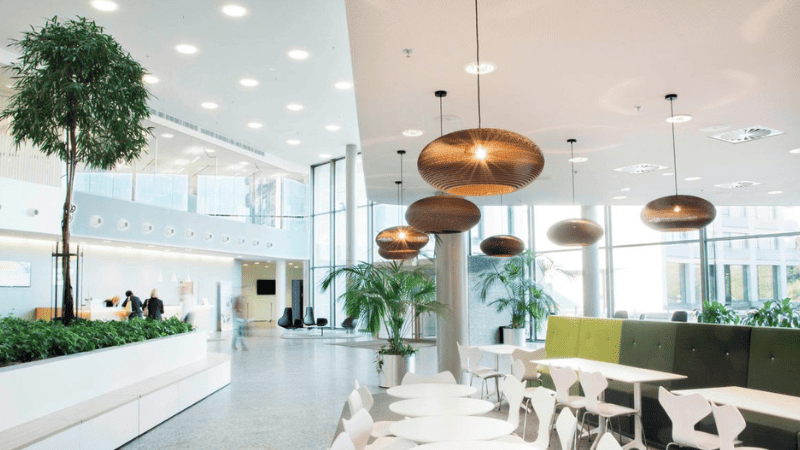
Why Are LED Lights Better for the Office?
LED lights are considered better for the office due to their energy efficiency, long lifespan, and improved lighting quality.
They consume less electricity than traditional bulbs, reducing energy costs in the long run. Also, they provide consistent and high-quality light that is conducive to office tasks and can even boost productivity.
Conclusion
Office lighting is crucial in creating a comfortable and productive work environment. By understanding the different types of office light fixtures available and avoiding common mistakes, you can choose the best lighting solution for your office space.
Remember to consider factors such as color temperature, positioning, and brightness to ensure optimal lighting for your needs. With the right office lighting, you can create a well-lit, visually appealing, and functional workspace for your employees. So, choose wisely and consult a professional when needed.
Visit R&C Lighting for all Your Office Lighting Needs!
Are you ready to transform your office lighting? At R&C Lighting, we offer a wide range of high-quality and energy-efficient lighting solutions for every type of office space. Whether you are looking for LED troffers, linear lighting, or any other type of office light fixture, we have got you covered.
Our team of experts can help you choose the best light fixtures tailored to your needs, ensuring maximum comfort, productivity, and cost savings. Contact us today to learn more or schedule a consultation!



